The artist S.C. Mero and the sculptures she’s left for you to discover on the streets of DTLA
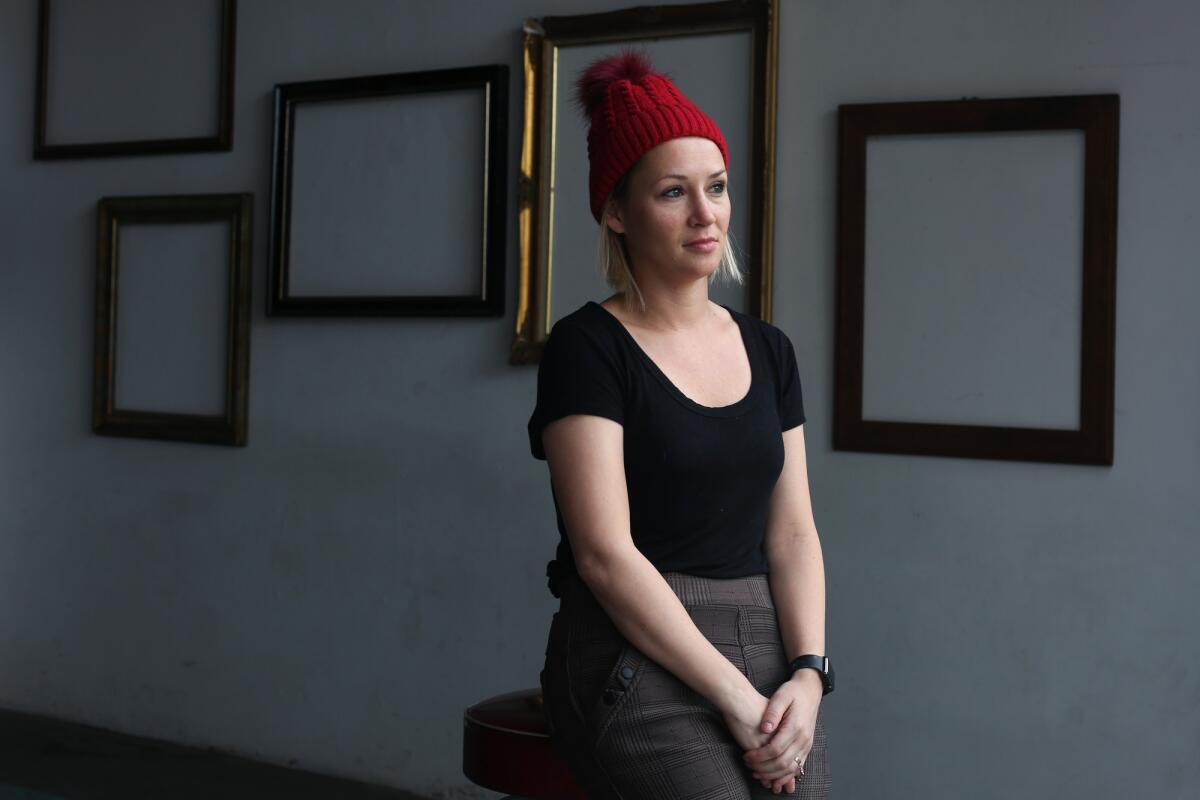
- Share via
You may have missed it at the L.A. Art Show over the weekend.
Amid the 130 galleries on the convention center floor, zooming past the Chinese ink paintings and intermittent performance art happenings was a lone orange construction cone on wheels. It zigzagged through as many as 20,000 people a day, befuddling onlookers and leaving delighted, squealing children in its wake. Some jumped out of its way. Others posed for selfies.
Never more than about 100 feet away was street artist S.C. Mero, controlling her artwork with a hand-held device. A commercial art fair in the convention center might have been a counterintuitive venue for a street artist, but that’s exactly the point, Mero said.
“I wanted to flip things,” she said. “A cone moving? It trips with your brain. It gives an inanimate object a personality and was just funny. And it’s just showing imagination. I think a lot of art and creativity is about showing possibilities of how things can be. The cone in motion throws people for a loop.”
The cone was part of Mero’s eight-piece solo exhibition presented by Art Share L.A., a nonprofit supporting emerging local artists. Mero’s public art installations, which she’s been making since she graduated from USC in 2011, typically dot the sidewalks of downtown L.A.’s Arts District, where Art Share L.A. is based. The conceptual sculptures employ humor to shed light on pressing urban issues such as gentrification, drug addiction and homelessness.
“I just love how Sarah directs a lens onto dire societal issues,” said Art Share L.A. Executive Director Cheyanne Sauter. “But she relies so much on the accidental audience, and I wanted to make that more intentional by bringing her there.”
Crowds, including celebrities such as comedians Patton Oswalt and Jeffrey Ross, stopped by to ogle her three-piece, 12-foot-long serpent made from wood and roofing felt, her fire hydrant on fire, as well as a mosaic made from stripped pennies and titled “Change.”
The real point of exhibiting at the convention center, Mero said, was to shine a spotlight on her street works and the issues they reflect — and to direct people outdoors, where the works are left to be admired, photographed, removed by the city or stolen. She creates the sculptures in her skid row art studio and sees the work as a public service of sorts. Art Share’s booth at the convention center had maps to five of Mero’s sculptural installations.
“I think it’s impossible not to be moved by the homelessness crisis,” she said. “Just moving one or two blocks over, from Main Street to Wall Street, you can’t believe it. The sanitation, the trash, the feces, just the living conditions.”
Only four of Mero’s five outdoor works connected to the L.A. Art Show remained on the streets by the start of this week. The day after the L.A. Art Show closed, Mero took The Times on a tour of her street sculptures. Here’s what she had to say about each one.
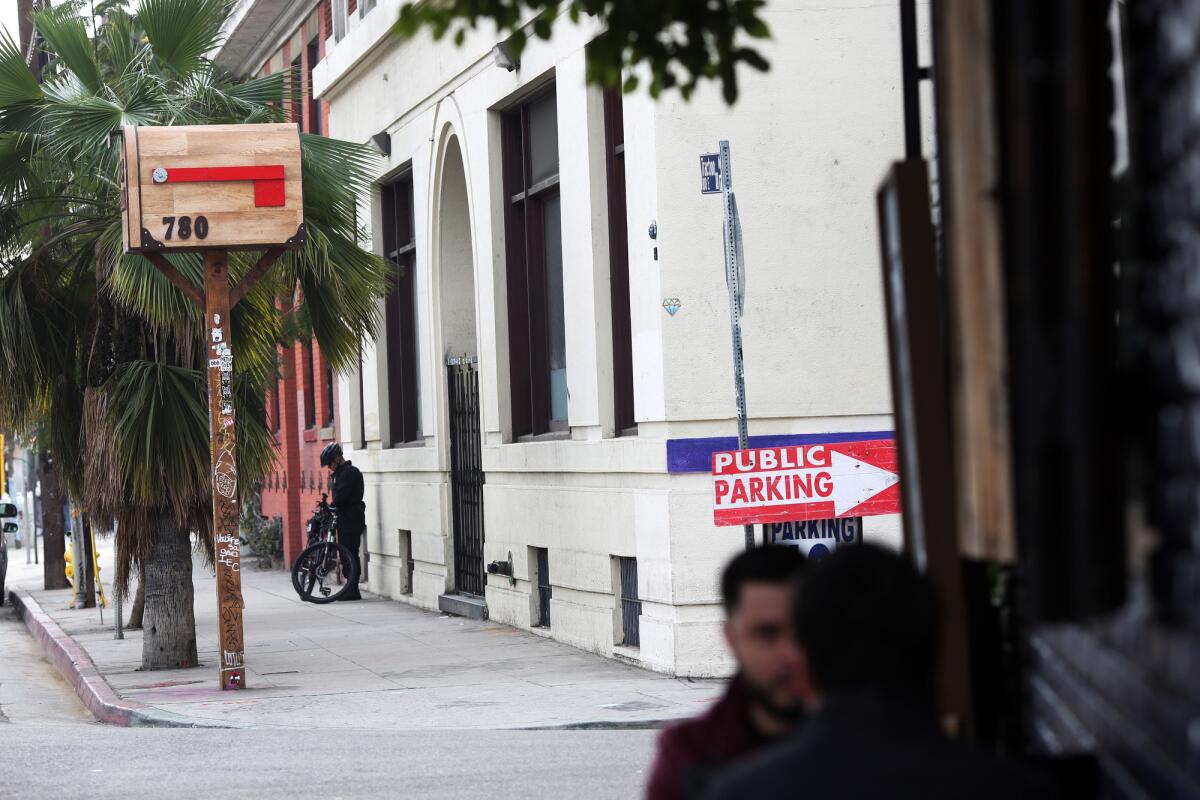
Untitled mailbox, corner of Hewitt Street and Traction Avenue
“It’s a street pole that didn’t have a sign,” Mero said. “Initially, I’d put a giant location pin on top of it. That was there a year. It was starting to crack, and I thought, ‘It’s gonna fall on someone,’ so I cut it off and replaced it with this. A lot of people see it as silly, a giant mailbox, but to me it has serious undertones because it’s a mailbox that wouldn’t be in a city. It’s a rural style. Those style of mailboxes come with owning a house — and nobody really owns anything in this area. That’s something out of reach. All the graffiti that gets added to it, I think really adds to it. Real mailboxes get hit with graffiti and damaged, so it takes on some authenticity.”
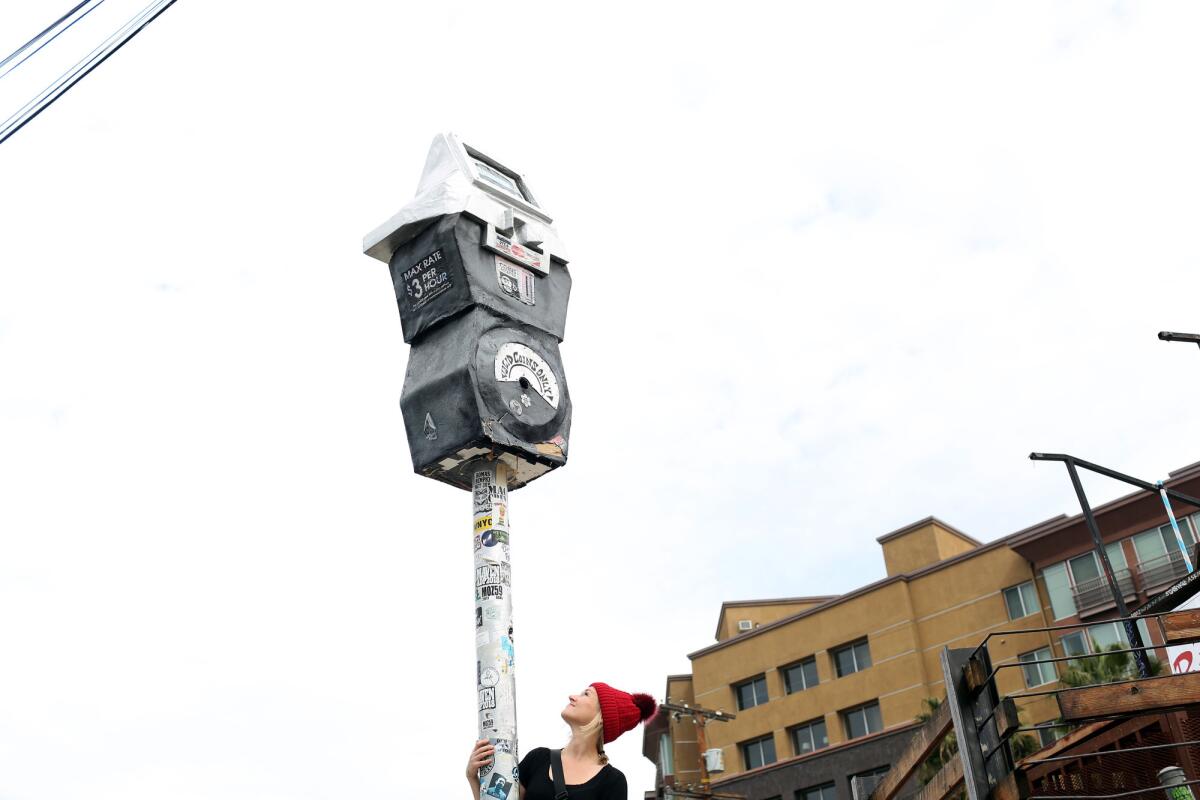
Untitled parking meter, Third Street at Traction Avenue
“What I had in mind here was how, when you’re in an urban area, you feel so powerless with parking. It’s overpowering and sort of above you. You have to sort of submit to parking in any urban area. It used to be really easy to park in this area, and now you have to pay everywhere,” Mero said. Why this corner? “There was an empty street pole here with no sign on it.”
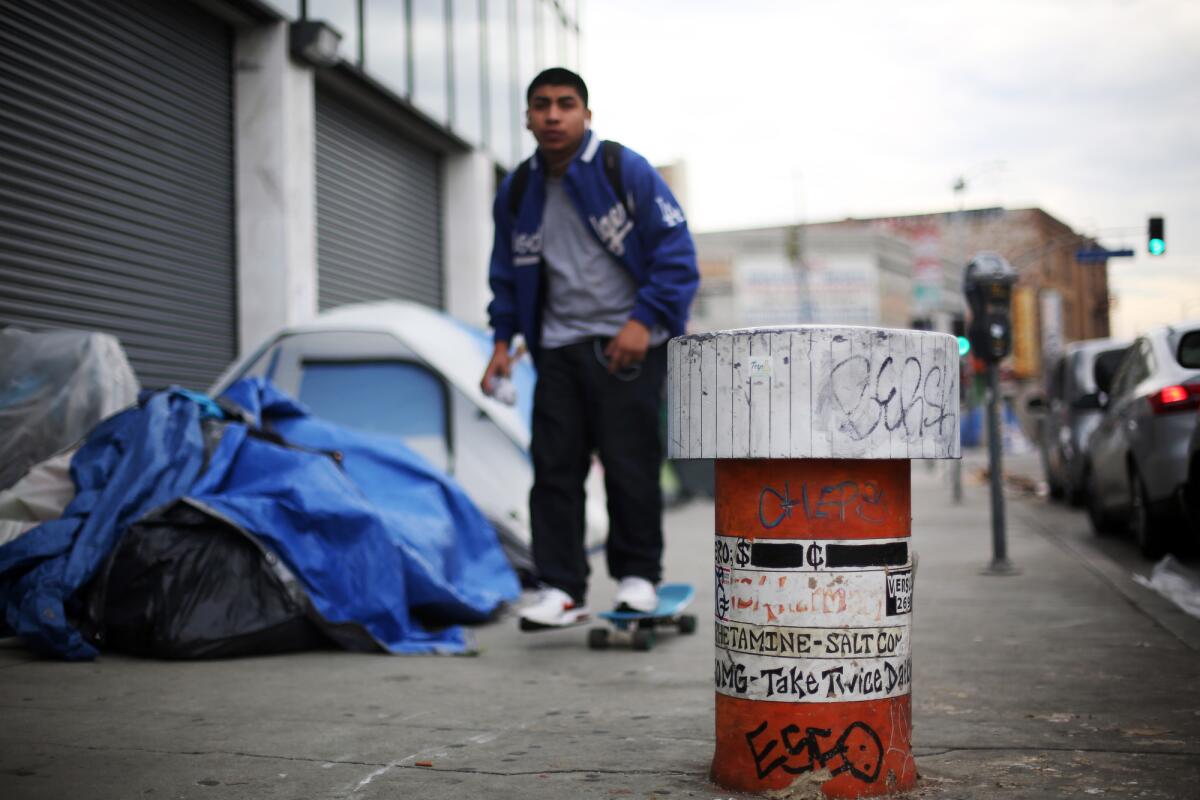
Untitled pill bottle on 5th Street between Wall Street and Maple Avenue
“This was previously just a concrete [stump] and I turned it into a prescription bottle,” Mero said. “This is the only art piece of mine that’s very personal. I used to have a drug problem, so I made this about myself. I got over that problem. I didn’t necessarily choose this location; it chose itself. [The stump] was just here. … I’m glad that I went through that because it took me to a level of understanding, and I don’t pass any judgement on people. I run into people all the time, and I just tell them, ‘Your life can get better if you get off drugs.’ That’s obviously going on all around here. It doesn’t matter what drug it is; it’s the same struggle for everybody.”
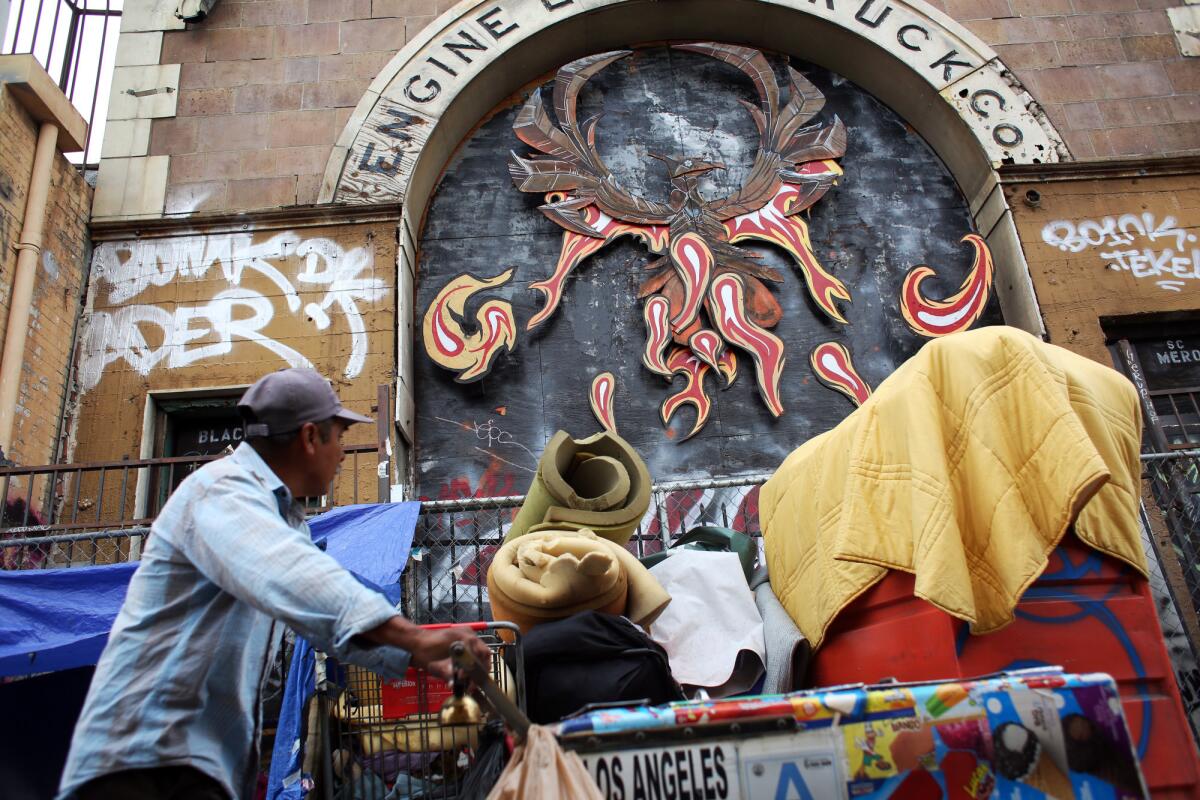
Fire Station No. 23 on fire, 5th Street between Maple Avenue and Los Angeles Street
“This is what’s left of a collaboration I did with Matthew Blackwell,” Mero said. It was when the skid row neighborhood council [vote] didn’t pass in 2017. It was devastating to the activists and all the people in the community. This was supposed to be a way to uplift people who were here. We built all these flames and made a phoenix rising out of the ashes. It was super beautiful. It lasted a long time. But then the flames slowly went out and disappeared. I heard they ended up in some people’s tents. Now it’s just the phoenix.”
And what about the fifth work of art — the one that vanished?
It was a mannequin’s leg holding an umbrella top at the corner of Alameda Street and 4th Place.
Mero isn’t bitter that it’s gone.
“Once I put something out there I let it go,” she said. “I can’t get too mad about what happens. Some street artists get really mad about that, but I’m already on to the next piece!”
Follow me on Twitter: @debvankin
More to Read
The biggest entertainment stories
Get our big stories about Hollywood, film, television, music, arts, culture and more right in your inbox as soon as they publish.
You may occasionally receive promotional content from the Los Angeles Times.











